When companies engage with external vendors, suppliers, or partners, there’s always a risk involved — whether it’s data breaches, regulatory complexities, or operational glitches. That’s where third-party risk management (TPRM) solutions become essential.
Simply put, these solutions assist organizations in monitoring their external partners, ensuring that they adhere to security best practices, regulatory requirements, and don’t introduce new risks to the business. Consider them digital watchdogs that assist organizations in creating safer, more secure partnerships.
In this blog, we will be discussing the 10 best third-party risk management solutions of 2025. Whether you are a small company just beginning to work with suppliers or a large corporation dealing with hundreds of external parties, these tools have the power to make an impact.
Why Do You Need Third-Party Risk Management Tools?
Here’s why third-party risk management (TPRM) tools are no longer a luxury but a necessity:
1. Increasing Cybersecurity Threats
Cyberattacks are no longer confined to direct attacks against large corporations. Hackers now commonly target smaller vendors that might have less robust defenses — utilizing them as an alleyway into larger organizations. TPRM tools assist in keeping an eye on vendor security procedures, detecting vulnerabilities, and ensuring that your partners are upholding robust cybersecurity measures.
2. Regulatory Compliance
Industry sectors such as finance, healthcare, and tech come under very strict regulatory regimes (e.g., GDPR, HIPAA, or SOX). If your suppliers get data wrong or do not obey regulations, your business may be subjected to fines, legal proceedings, or reputational loss. TPRM solutions make compliance easier by having ongoing assessment, documentation, and reporting capabilities.
3. Operational Continuity
A vendor failure — data center outage, delayed delivery, or financial meltdown — can critically halt your operations. Risk management utilities assist you in evaluating key vendors in advance and developing contingency strategies, so your business isn’t left reeling.
4. Reputation Protection
Collaborating with a supplier who uses unethical behaviors or experiences a publicized violation can damage your brand’s reputation. TPRM tools assist you in thoroughly screening and monitoring the third parties to ensure that their actions are consistent with the values and standards of your company.
5. Efficiency and Scalability
Manually monitoring risk on each vendor soon gets out of control, particularly as your business expands. TPRM software automates the checks, monitors risk scores, sends notifications, and creates in-depth reports — saving time and minimizing human error.
6. Smarter Decision-Making
With end-to-end visibility into vendor risks, your business can make faster, wiser decisions — whether that’s negotiating more favorable terms, selecting safer partners, or cutting ties with risky relationships before they do harm.
10 Best Third-Party Risk Management Tools for 2025
1. Panorays

Panorays is a top SaaS-based third-party security risk management platform, established in 2016 and headquartered in New York City. Intended to assist organizations in managing and mitigating cyber risks linked to their external vendors, Panorays provides an extensive set of tools that automate the complete third-party risk management (TPRM) lifecycle—from initial assessments to ongoing monitoring and remediation. Panorays offers ongoing vendor monitoring, with real-time notification of any shift in their cyber stance. This way, organizations are able to act immediately to threats that are on the rise.
Features:
- Automated Third-Party Security Assessments
- Continuous Vendor Monitoring
- Risk DNA™ – Contextual Risk Rating
- AI-Powered Security Questionnaire Automation
- Customizable Risk Policies
- Automated Remediation Management
- Regulatory Compliance Support (e.g., GDPR, CCPA, NYDFS)
- External Attack Surface Management
- Vendor Collaboration Portal
- Executive Reporting and Custom Dashboards
- Seamless Integrations with Existing Systems
- Scalable for Organizations of All Sizes
Pricing:
contact them for prices of these plans;
- Basic: Designed for organizations managing up to 25 continuous vendor assessments.
- Premium: Supports 26–75 continuous vendor assessments.
- Enterprise: Caters to 76–100 continuous vendor assessments.
- Strategic: Ideal for managing 101–150 continuous vendor assessments.
Website: https://panorays.com
2. SecurityScorecard
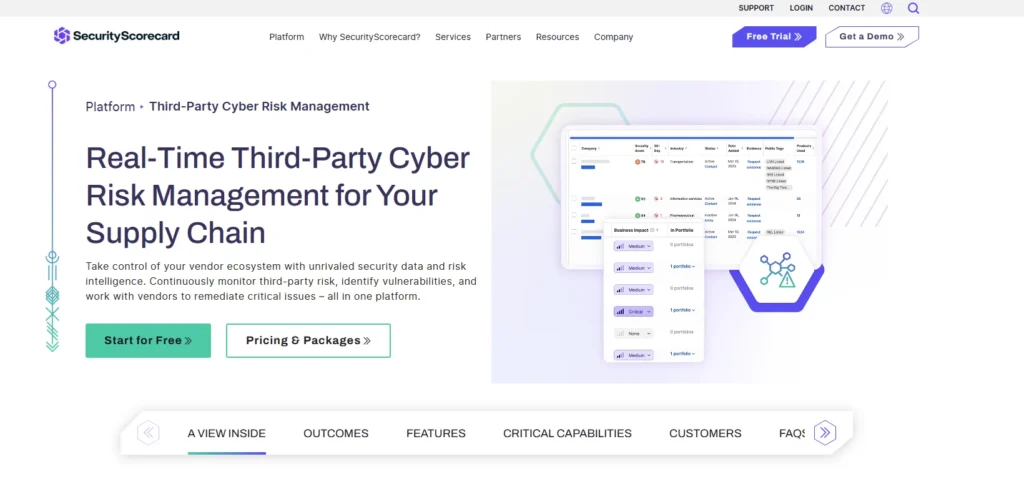
SecurityScorecard’s Third-Party Cyber Risk Management platform provides an integrated solution for organizations that need to monitor and mitigate their vendor ecosystem-related cybersecurity risks. Providing real-time visibility into third-party security posture, the platform allows firms to detect vulnerabilities, evaluate risks, and work with vendors to remediate top-priority issues all within a single pane of glass. The platform also features breach notifications and incident alerts, keeping businesses ahead of the curve in managing risks and staying regulatory compliant.
Features:
- Instant Risk Assessment
- Portfolio Management
- Collaborative Remediation
- Continuous Monitoring
- Incident and Breach Alerts
- Digital Footprint Analysis
- Real-Time Risk Visibility
- Compliance Assurance
- Vendor Collaboration at No Cost
- Actionable Risk Insights
Pricing:
contact them for prices of these plans;
- Free Plan: Access your own security rating with a 14-day trial of the Business Plan.
- Business Plan: Monitor up to 5 vendors with daily alerts, API integration, and more.
- Enterprise Plan: Custom vendor monitoring with advanced features and dedicated support.
- MAX Managed Service: Full-service managed offering for proactive third-party risk management and breach detection.
Website: https://securityscorecard.com
3. Vanta

Vanta Third-Party Risk Management (TPRM) platform is created to assist companies in identifying, evaluating, and managing the risks that come with their third-party vendors, contractors, and partners.
With organizations more and more depending on third-party services for numerous functions, the necessity of managing these risks has grown increasingly important. Vanta makes this easy by offering end-to-end visibility into your third-party vendors’ risk profiles. This allows companies to make well-informed decisions regarding their relationships with suppliers and prevent them from getting into unnecessary risk.
Features:
- Automated Vendor Discovery
- Centralized Third-Party Inventory
- Real-Time Risk Monitoring
- AI-Powered Security Reviews
- Continuous Compliance Support
- Risk Assessment & Reporting
- Customizable Risk Frameworks
- Collaboration with Vendors
- Seamless Integrations
- Scalable for Organizations of All Sizes
Pricing:
- Core: Designed for startups, this plan includes essential compliance tools and is priced at approximately $10,000 per year.
- Collaborate: Aimed at growing teams, it adds advanced features and is priced at $13,500 per year.
- Scale: For mature security environments, this plan offers extensive customization and is priced at $20,000 per year.
- Enterprise: Tailored for large organizations, this plan provides complete customization, with pricing available upon request.
Website: https://www.vanta.com
Suggested Read: VPN Services
4. RiskRecon

RiskRecon’s Third-Party Risk Management platform gives organizations complete visibility into their vendors’ cybersecurity postures through real-time data and sophisticated analytics. It assists companies in evaluating and prioritizing third-party risks efficiently by streamlining risk prioritization, tailoring risk policies, and providing AI-driven assessments.
The platform also has continuous monitoring to monitor vendor security postures and collaborative remediation workflows to involve vendors in mitigating discovered risks. This allows organizations to manage third-party risks ahead of time and improve their security overall.
Features:
- Automated Risk Prioritization
- Custom-Tuned Risk Policies
- AI-Powered Assessments
- Continuous Monitoring
- Collaborative Remediation Workflows
- Real-Time Data and Analytics
- Vendor Risk Scoring
- Supply Chain Security Management
Pricing:
customized pricing
Website: https://www.riskrecon.com
5. OneTrust
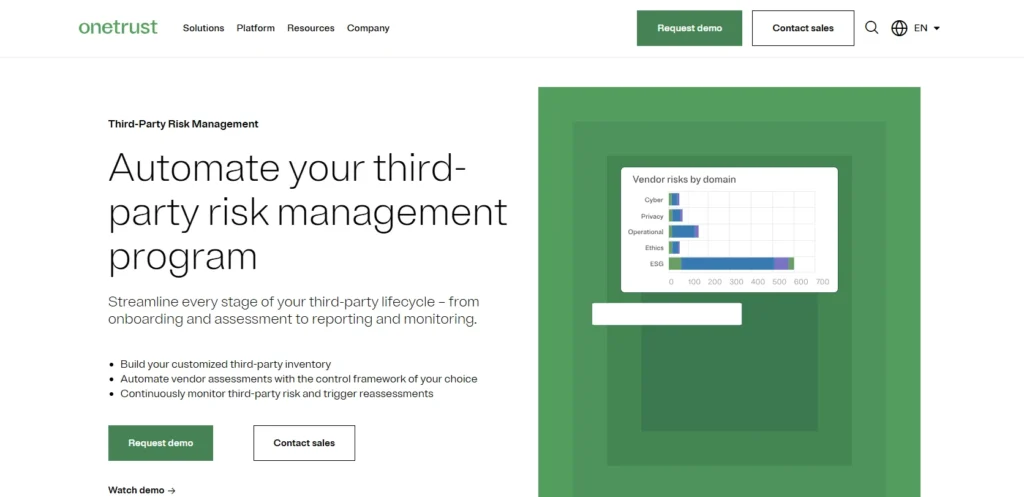
OneTrust Third-Party Risk Management platform provides an end-to-end solution to automate all phases of the third-party lifecycle from onboarding and risk assessment to reporting and monitoring. The major features include automated vendor risk assessments with customizable templates, centralized third-party inventory for better visibility, and automated risk mitigation processes using more than 50 pre-built control frameworks.
The platform also includes ongoing monitoring of third-party performance, real-time notifications of new risks or vulnerabilities, and configurable dashboards for monitoring important metrics and retaining compliance records.
Features:
- Automated Vendor Assessments
- Centralized Third-Party Inventory
- Automated Risk Mitigation
- Continuous Monitoring
- Compliance Tracking
- Customizable Dashboards
- Risk Assessment Templates
- Built-in Control Frameworks
- Real-time Alerts and Notifications
Pricing:
- Base Plan: Priced between $6,000 to $18,000 per year, designed for smaller organizations with essential features.
- Enterprise Plan: Custom pricing for larger organizations with advanced features and complex requirements.
Website: https://www.onetrust.com
6. Drata
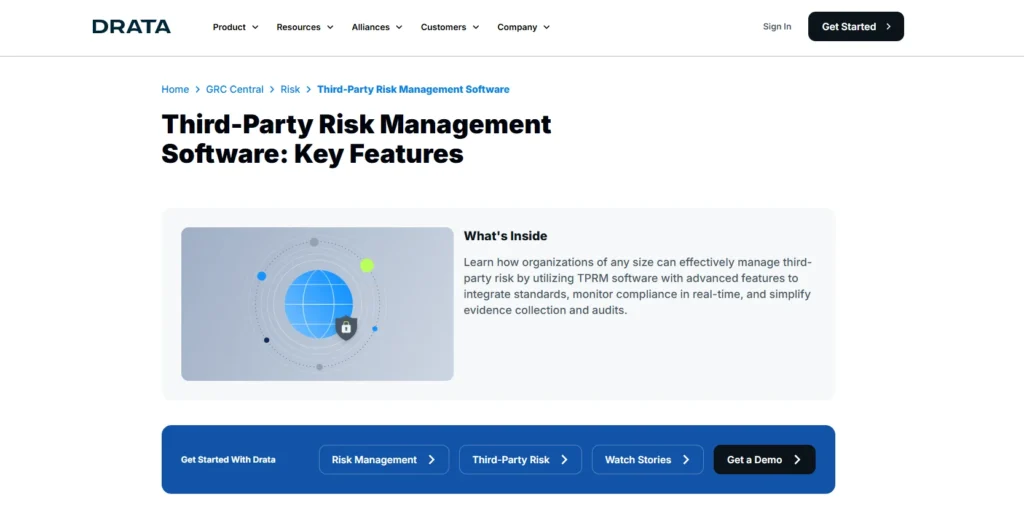
Drata Third-Party Risk Management software is an end-to-end solution that enables organizations to evaluate and monitor third-party vendor risks. The software seamlessly integrates with multiple compliance standards, including GDPR, ISO 27001, and SOC 2, to provide real-time monitoring for compliance.
Real-time control monitoring, automated evidence collection for audit purposes, and a centralized evidence repository are among the features the platform provides. Moreover, it offers sophisticated risk assessments, customizable reporting, and actionable analytics, allowing organizations to manage third-party risks proactively and ensure a secure and compliant environment.
Features:
- Standards Integration
- Real-Time Control Monitoring
- Evidence Collection and Audits
- Comprehensive Evidence Library
- Automated Evidence Collection
- Advanced Audit Capabilities
- Detailed Risk Assessment
- Configurable Reporting and Actionable Analytics
Pricing:
- Essential Plan: Priced around $7,500 per year for small organizations with basic compliance needs.
- Foundational Plan: Starts at $15,000 per year, ideal for medium-sized businesses needing advanced features.
- Advanced Plan: Custom pricing, typically ranging from $10,000 to $50,000+ per year, tailored for enterprises with complex requirements.
Website: https://drata.com
7. BitSight
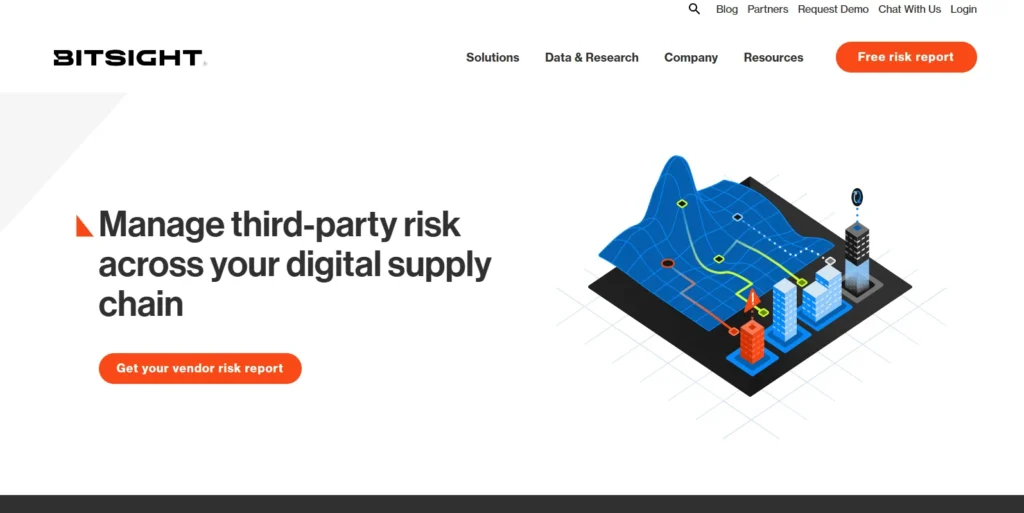
BitSight provides an all-encompassing Third-Party Risk Management platform that enables companies to evaluate, track, and manage risks relating to their vendor network. Utilizing real-time security ratings and continuous monitoring, BitSight allows companies to anticipate and handle third-party cyber threats.
Its features encompass automated vendor evaluations, real-time views into vendor security performance, detection of vulnerabilities, and a unified third-party risk data hub, all to deliver a secure and compliant supply chain.
Features:
- Vendor Risk Management
- Continuous Monitoring
- Vulnerability Detection
- Trust Management Hub
- Automated Vendor Assessments
- Real-Time Security Ratings
- Risk Data Centralization
Pricing:
customized pricing
Website: https://www.bitsight.com
8. ProcessUnity
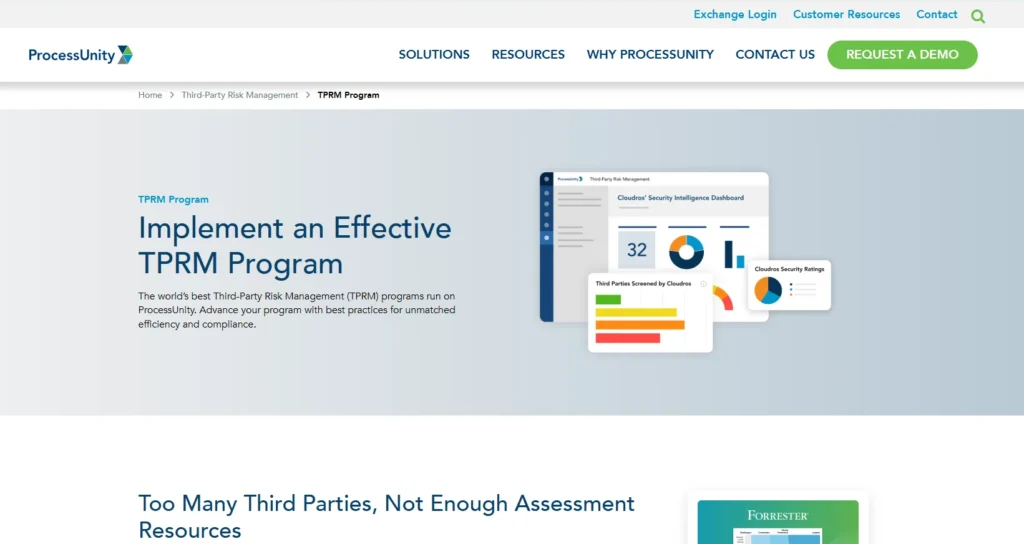
ProcessUnity’s Third-Party Risk Management (TPRM) Program V is a complete solution for discovering, evaluating, and managing third-party vendor risks. The software streamlines key TPRM functions, such as sourcing, onboarding, post-contract due diligence, vendor service reviews, and offboarding, to deliver a seamless and effective vendor risk management lifecycle.
With the addition of CyberGRX’s international cyber risk exchange, ProcessUnity broadens its features by giving customers access to more than 360,000 hand-curated vendor risk profiles, greatly decreasing workloads associated with assessments and increasing coverage across the entire vendor network.
Features:
- Automated Vendor Onboarding
- Post-Contract Due Diligence
- Vendor Service Reviews
- Offboarding Workflows
- Global Risk Exchange Integration
- Threat & Vulnerability Response
- Cybersecurity Risk Management
- Interactive Dashboards & Reporting
- Advanced Risk Scoring & Prioritization
- Bidirectional API Integrations
Pricing:
- Small & Medium Businesses – From $25,000/year – Out-of-the-box solution with automated workflows, vendor assessments, and reporting tools.
- Emerging Enterprises – From $25,000/year – For companies with $500M to $3B revenue, offering enhanced customization and scalability.
- Large Enterprises – Custom Pricing – Tailored for global organizations with complex requirements, offering advanced customization and integration.
Website: https://www.processunity.com
9. Black Kite

Black Kite is a third-party cyber risk management platform that offers complete, real-time intelligence to help organizations evaluate, monitor, and mitigate risks in their vendor ecosystem. Using open-source threat intelligence and non-intrusive cyber reconnaissance, Black Kite provides technical cyber scores, Open FAIR™ model-based financial risk quantification, and compliance automation. The platform provides distinguishing features like the Ransomware Susceptibility Index®, forecast threat intelligence by FocusTags™, and a Supply Chain Module to detect nth-party risks.
Features:
- Real-Time Cyber Risk Ratings
- Ransomware Susceptibility Index®
- FocusTags™ Predictive Threat Intelligence
- Supply Chain Risk Management
- Open FAIR™ Financial Risk Quantification
- Compliance Automation
- Technical Cyber Ratings
- Open-Source Threat Intelligence
- Non-Intrusive Cyber Reconnaissance
Pricing:
customized pricing
Website: https://blackkite.com
10. UpGuard

UpGuard’s Third-Party Risk Management (TPRM) platform provides a holistic solution for evaluating, tracking, and managing risks related to third-party vendors.
The platform offers real-time security ratings, ongoing monitoring, and automated risk analysis to assist organizations in being proactive about managing vendor risks. UpGuard’s TPRM solution allows businesses to automate vendor risk management processes, improve compliance, and build a stronger overall cybersecurity stance.
Features:
- Real-Time Security Ratings
- Continuous Monitoring
- Automated Risk Assessments
- Vendor Risk Management
- Compliance Management
- Security Posture Insights
- Centralized Dashboard
- Incident Response Tracking
- Data-Driven Risk Analytics
Pricing:
- Free Plan – $0/month, monitor up to 5 vendors with security ratings and workflows.
- Starter Plan – $1,599/month (annually), monitor up to 50 vendors with API integrations and identity breach detection.
- Professional Plan – $3,333/month (annually), monitor up to 150 vendors with custom branding and automated vendor classification.
- Enterprise Plan – Custom pricing, monitor unlimited vendors with advanced features and dedicated support.
Website: https://www.upguard.com
How to Choose the best Third-Party Risk Management Tool?
Selecting the right third-party risk management (TPRM) tool can be daunting, given the numerous choices out there. But the secret is to select a solution that aligns with your business requirements, your industry norms, and the extent of risk you’re exposed to. Here’s a quick guide to assist you in selecting the ideal TPRM tool:
1. Know Your Business Needs
Begin by defining what you actually require. Do you have a few vendors to manage or several hundred? Do you work in a highly regulated space? Are cybersecurity threats your greatest worry, or is the need for financial sustainability paramount? Understanding your priorities will allow you to screen tools that fit within your unique risk environment.
2. Seek Total Risk Assessment Capabilities
A good TPRM tool should go beyond simple questionnaires. It should offer in-depth risk assessments covering cybersecurity, compliance, financial health, operational risks, and reputational factors. Modern solutions often include AI tools for cybersecurity to detect threats proactively and enhance risk visibility. The more detailed and customizable the assessments, the better equipped you’ll be to spot potential problems early.
3. Automation and Scalability
Manually monitoring vendor risks is time-consuming and error-prone. Seek out solutions that automate important functions such as risk scoring, report creation, and vendor tracking. Also, select a solution that can scale with your business — handling more vendors, more information, and more sophisticated risk profiles as you grow.
4. Real-Time Monitoring and Alerts
Risk isn’t fixed — vendors’ risk profiles can shift overnight. Select a platform that provides real-time risk intelligence and alerts you instantly if a vendor’s risk status alters. Ongoing monitoring keeps you ahead of would-be threats.
5. Ease of Use
An effective tool won’t do much good if it is too cumbersome to operate. Seek out interactive dashboards, simple navigation, and adaptable workflows. An interface that is easy to use guarantees that your risk management staff (and even non-technical people) can realize the full potential of the tool without an overwhelming learning curve.
6. Integration Capabilities
The top TPRM solutions seamlessly integrate with your current systems — such as your procurement software, CRM, ERP, or cybersecurity solutions. Integrating TPRM minimizes the data silos and provides smoother processes across your organization.
7. Support for Regulatory Compliance
If your business has to adhere to rigid compliance (such as GDPR, HIPAA, PCI-DSS), ensure that the tool includes functionality such as audit trails, compliance reports, and doc templates. This does not just ease compliance but assists with audits too.
8. Vendor Risk Lifecycle Management
Risk management doesn’t stop when you sign a contract with a vendor. Select a tool that accommodates the entire vendor lifecycle — onboarding and due diligence through monitoring, contract management, and offboarding.
9. Customization and Reporting
Each business has unique reporting requirements. Search for platforms that enable you to tailor risk metrics, scoring models, and create rich, flexible reports for varied stakeholders such as compliance teams, executives, or auditors.
10. Cost vs. Value
Budget is always an issue, but don’t settle for the lowest price. Consider the tool’s long-term value — how much time it will save you, how well it will keep risks at bay, and how well it will facilitate your business’s growth and compliance initiatives.
Conclusion
Selecting the correct third-party risk management tools isn’t merely about checking a box — it’s about safeguarding your business, upholding customer trust, and remaining compliant in a more complex world.
The tools we’ve identified for 2025 are meant to assist you in monitoring your vendors more efficiently, automating risk evaluations, and acting quickly on possible threats. Whether you’re an expanding startup or a big business, investing in a robust TPRM solution today can prevent you from having serious headaches tomorrow. Take the time to evaluate your needs thoroughly, look around, and discover the tool that best suits your organization — your future self will appreciate it.
FAQs
How does ongoing monitoring in a TPRM tool function?
Ongoing monitoring refers to the fact that the tool monitors vendors in real time or near real time. It monitors changes such as cybersecurity breaches, financial instability, compliance issues, or reputational concerns — and notifies you if a vendor’s risk profile significantly changes.
Can a TPRM tool be integrated with current business systems?
Absolutely. The top TPRM solutions seamlessly integrate with your CRM, ERP, procurement, and cybersecurity systems. This provides smoother data exchange, reduces manual effort, and provides you with a better picture of vendor risk across your enterprise.
What if a third-party vendor is identified as high-risk?
When a vendor is identified as high-risk, the TPRM tool usually suggests follow-up steps — like asking for more security controls, re-negotiating contract terms, or even replacing the vendor if needed. Early warnings enable you to act before major issues happen.
Are cloud-based TPRM tools secure to use?
Yes — legitimate cloud-based TPRM solutions adhere to rigorous security practices such as data encryption, access controls, and periodic audits. Always ensure that the vendor adheres to certifications such as ISO 27001, SOC 2, or GDPR compliance prior to selecting a cloud-based platform.
How long does it take to implement a TPRM tool?
Implementation duration depends on the complexity of the tool and the size of your organization. Some light-weight platforms can be implemented in a matter of weeks, whereas more advanced enterprise-grade solutions can take several months for complete rollout, training, and integration.

